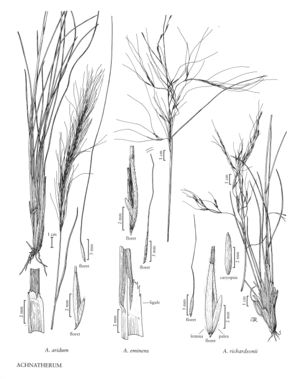Difference between revisions of "Achnatherum eminens"
imported>Volume Importer |
imported>Volume Importer |
||
| Line 43: | Line 43: | ||
|publication year= | |publication year= | ||
|special status= | |special status= | ||
| − | |source xml=https:// | + | |source xml=https://bitbucket.org/aafc-mbb/fna-data-curation/src/2e0870ddd59836b60bcf96646a41e87ea5a5943a/coarse_grained_fna_xml/V24/V24_177.xml |
|subfamily=Poaceae subfam. Pooideae | |subfamily=Poaceae subfam. Pooideae | ||
|tribe=Poaceae tribe Stipeae | |tribe=Poaceae tribe Stipeae | ||
Revision as of 20:49, 5 November 2020
Plants cespitose, shortly rhizomatous, bases knotty. Culms 50-100 cm tall, 0.8-1.5 mm thick, glabrous; nodes 2-3. Basal sheaths mostly glabrous, ciliate on the margins; collars glabrous on the back, usually with tufts of hair on the sides, hairs about 0.8 mm; basal ligules 0.8-1.6 mm, membranous, glabrous, rounded to acute; upper ligules to 4.5 mm, acute; blades 0.7-3.5 mm wide, abaxial surfaces smooth to scabridulous, adaxial surfaces prominently ribbed, scabridulous or sparsely to densely pubescent, hairs about 0.1 mm. Panicles 20-55 cm long, 3-8 cm wide, open, often enclosed to midlength at anthesis; lower branches 5-8 cm, ascending to divergent, flexuous. Lower glumes 5-12 mm long, 0.5-0.7 mm wide, 3-5-veined; upper glumes 1-4 mm shorter, 3-veined; florets 4-7.5 mm long, 0.5-0.9 mm thick, fusiform, terete; calluses 1-2 mm, sharp; lemmas evenly hairy, hairs 0.4-0.8 mm throughout, apical lobes not present; awns 35-70 mm, persistent, twice-geniculate, first 2 segments scabrous, terminal segment flexuous; paleas 1-2 mm, 1/3 – 1/2 as long as the lemmas, sparsely to moderately pubescent, apices rounded, flat; anthers 3-3.5 mm, dehiscent, a few penicillate, hairs about 0.3 mm. Caryopses about 4 mm, fusiform. 2n = 44, 46.
Distribution
Ariz., N.Mex., Tex.
Discussion
Achnatherum eminens grows on dry, rocky slopes and valleys in the mountains of the southwestern United States, primarily in desert scrub, at 600-2600 m. Its range extends into Mexico. It is easy to recognize because of its open panicle, flexuous branches, and flexuous awns. It is superficially similar to Nassella cernua, but differs in its longer, glabrous ligules, not or weakly overlapping lemma margins, pubescent paleas, and geographic distribution.
Selected References
None.
